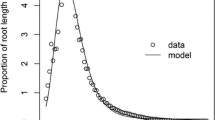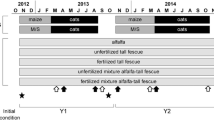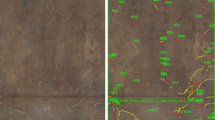Abstract
Mastering ecological dynamics necessitates identifying the substance cycles in biomass. In terms of sustainable soil productivity, the nutrient content of below-ground biomass is just as significant as the above-ground biomass, which fluctuates depending on land use. Yet, there were limited studies on determining the quantity of plant nutrient stocks, particularly in the below-ground biomass, in rangeland, forest, and plantation areas coexisting in the same ecological zone. In this regard, it is expected that the findings of this study will contribute to the literature. For this purpose in mind, distinct samples were taken from three depth levels (0–10 cm, 10–20 cm, 20–30 cm) to determine root biomass and nutrient stocks of roots in neighboring rangeland, forest, and plantation areas, and roots were divided into diameter classes, and below-ground biomass amounts and nutritional contents of below-ground biomass were determined. According to the results obtained, the total root biomass in the rangelands is 8.02 Mg ha−1, total root biomass was 5.95 Mg ha−1 in forest areas, and in plantation areas, the total root biomass is 6.94 Mg ha−1. Root biomass in the 0–10 cm soil layer constituted 78% of the total biomass. Also, for all land uses, the highest below-ground biomass concentrations were observed for Al, Fe, K, Mg, and Ca. The amounts of Al, Fe, K and Mg in the below-ground biomass followed the sequence of rangeland, plantation, and forest from high to low. Nutrient stocks in below-ground biomass and the effects of increases in root biomass on plant growth should be evaluated by future studies.






Similar content being viewed by others
Data availability
The authors confirm that the data supporting the findings of this study are available within the article and/or its supplementary materials.
References
Bardgett, R. D., Mommer, L., & De Vries, F. T. (2014). Going underground: Root traits as drivers of ecosystem processes. Trends in Ecology & Evolution, 29(12), 692–699.
Brassard, B. W., Chen, H. Y., Bergeron, Y., & Paré, D. (2011). Differences in fine root productivity between mixed-and single-species stands. Functional Ecology, 25(1), 238–246.
Cahill, J. F., McNickle, G. G., Haag, J. J., Lamb, E. G., Nyanumba, S. M., & Clair, C. C. S. (2010). Plants integrate information about nutrients and neighbors. Science, 328(5986), 1657–1657.
Canadell, J., Jackson, R., Ehleringer, J., Mooney, H., Sala, O., & Schulze, E.-D. (1996). Maximum rooting depth of vegetation types at the global scale. Oecologia, 108(4), 583–595.
Chen, W., Koide, R. T., & Eissenstat, D. M. (2017). Root morphology and mycorrhizal type strongly influence root production in nutrient hot spots of mixed forests. Journal of Ecology, 106(1), 148–156.
Chen, W., Zhang, Q., Cihlar, J., Bauhus, J., & Price, D. T. (2004). Estimating fine-root biomass and production of boreal and cool temperate forests using above-ground measurements: A new approach. Plant and Soil, 265(1), 31–46.
Claus, A., & George, E. (2005). Effect of stand age on fine-root biomass and biomass distribution in three European forest chronosequences. Canadian Journal of Forest Research, 35(7), 1617–1625.
Domisch, T., Finér, L., Dawud, S. M., Vesterdal, L., & Raulund-Rasmussen, K. (2015). Does species richness affect fine root biomass and production in young forest plantations? Oecologia, 177(2), 581–594.
Eisenhauer, N., Lanoue, A., Strecker, T., Scheu, S., Steinauer, K., Thakur, M. P., & Mommer, L. (2017). Root biomass and exudates link plant diversity with soil bacterial and fungal biomass. Scientific Reports, 7(1), 1–8.
Eissenstat, D., Wells, C., Yanai, R., & Whitbeck, J. (2000). Building roots in a changing environment: Implications for root longevity. New Phytologist, 147(1), 33–42.
Finér, L., Helmisaari, H. S., Lõhmus, K., Majdi, H., Brunner, I., Børja, I., Eldhused, T., Godbold, D.,Grebenc, T., Konôpka, B., Kraigher, H., Slovenia, M. R., Möttönen, M., Ohashi, J., Oleksyn, I., Ostonen, V., Uri, E., & Vanguelova, E. (2007). Variation in fine root biomass of three European tree species: Beech (Fagus sylvatica L.), Norway spruce (Picea abies L. Karst.), and Scots pine (Pinus sylvestris L.). Plant Biosystems, 141(3), 394–405.
Finér, L., Ohashi, M., Noguchi, K., & Hirano, Y. (2011). Factors causing variation in fine root biomass in forest ecosystems. Forest Ecology and Management, 261(2), 265–277.
Gierus, M., Kleen, J., Loges, R., & Taube, F. (2012). Forage legume species determine the nutritional quality of binary mixtures with perennial ryegrass in the first production year. Animal Feed Science and Technology, 172(3–4), 150–161.
Gill, R. A., & Jackson, R. B. (2000). Global patterns of root turnover for terrestrial ecosystems. New Phytologist, 147(1), 13–31.
Gleeson, S. K., & Tilman, D. (1992). Plant allocation and the multiple limitation hypothesis. The American Naturalist, 139(6), 1322–1343.
Griffiths, M., & York, L. M. (2020). Targeting root ion uptake kinetics to increase plant productivity and nutrient use efficiency. Plant Physiology, 182(4), 1854–1868.
Helmisaari, H.-S., Derome, J., Nöjd, P., & Kukkola, M. (2007). Fine root biomass in relation to site and stand characteristics in Norway spruce and Scots pine stands. Tree Physiology, 27(10), 1493–1504.
Hooper, D. U., Adair, E. C., Cardinale, B. J., Byrnes, J. E., Hungate, B. A., Matulich, K. L., Gonzalez, A., Duffy, J. E., Gamfeldt, L., & O’Connor, M. I. (2012). A global synthesis reveals biodiversity loss as a major driver of ecosystem change. Nature, 486(7401), 105–108.
Jackson, R. B., Mooney, H. A., & Schulze, E.-D. (1997). A global budget for fine root biomass, surface area, and nutrient contents. Proceedings of the National Academy of Sciences, 94(14), 7362–7366.
Kroon, H., Hendriks, M., van Ruijven, J., Ravenek, J., Padilla, F. M., Jongejans, E., Visser, E. J. V., & Mommer, L. (2012). Root responses to nutrients and soil biota: Drivers of species coexistence and ecosystem productivity. Journal of Ecology, 100(1), 6–15.
Lange, M., Eisenhauer, N., Sierra, C. A., Bessler, H., Engels, C., Griffiths, R. I., Mellado-Vázquez, P. L., Malik, A. A., Roy, J., Scheu, S., Steinbeiss, S., Thomson, B. C., Trumbore, S. E., & Gleixner, G. (2015). Plant diversity increases soil microbial activity and soil carbon storage. Nature Communications, 6(1), 1–8.
Li, Y., Wang, Y., Shen, X., & Liu, F. (2021). The combinations of sulfur and molybdenum fertilizations improved antioxidant capacity of grazing Guizhou semi-fine wool sheep under copper and cadmium stress. Ecotoxicology and Environmental Safety, 222, 112520.
Li, W., Finnegan, P. M., Dai, Q., Guo, D., & Yang, M. (2021b). Metabolic acclimation supports higher aluminium-induced secretion of citrate and malate in an aluminium-tolerant hybrid clone of Eucalyptus. BMC Plant Biology, 21(1), 1–12.
Li, X., Zhang, X., Wu, J., Shen, Z., Zhang, Y., Xu, X., Fan, Y., Zhao, Y., & Yan, W. (2011). Root biomass distribution in alpine ecosystems of the northern Tibetan Plateau. Environmental Earth Sciences, 64(7), 1911–1919.
Liu, Y., Geng, X., Wei, D., & Dai, D. (2020). Grazing exclusion enhanced net ecosystem carbon uptake but decreased plant nutrient content in an alpine steppe. Catena, 195, 104799.
Luizão, F. J., Luizão, R. C., & Proctor, J. (2007). Soil acidity and nutrient deficiency in central Amazonian heath forest soils. Plant Ecology, 192(2), 209–224.
Ma, W., Yang, Y., He, J., Zeng, H., & Fang, J. (2008). Above-and below-ground biomass in relation to environmental factors in temperate grasslands, Inner Mongolia. Science in China Series C: Life Sciences, 51(3), 263–270.
McCormack, M. L., Dickie, I. A., Eissenstat, D. M., Fahey, T. J., Fernandez, C. W., Guo, D., Helmisaari, H. S., Hobbie, E., Iversen, C. M., Jackson, R. B., Leppalammi-Kujansuu, J., Norby, R. J., Phillips, R. P., Pregitzer, K. S., Pritchard, S. G., Rewald, B., & Zadworny, M. (2015). Redefining fine roots improves understanding of below-ground contributions to terrestrial biosphere processes. New Phytologist, 207(3), 505–518.
Mofidi, M., Jafari, M., Tavili, A., Rashtbari, M., & Alijanpour, A. (2013). Grazing exclusion effect on soil and vegetation properties in Imam Kandi Rangelands. Iran. Arid Land Research and Management, 27(1), 32–40.
Mommer, L., Cotton, T. A., Raaijmakers, J. M., Termorshuizen, A. J., van Ruijven, J., Hendriks, M., Rijssel, S. Q., Mortel, J. E., Paauw, J. W., Schijlen, E., Smit- Tiekstra, A. E., Berends, F., Kroon, H., & Dumbrell, A. J. (2018). Lost in diversity: The interactions between soil-borne fungi, biodiversity and plant productivity. New Phytologist, 218(2), 542–553.
Munkholm, L. J., Hansen, E. M., & Olesen, J. E. (2008). The effect of tillage intensity on soil structure and winter wheat root/shoot growth. Soil Use and Management, 24(4), 392–400.
Mueller, K. E., Tilman, D., Fornara, D. A., & Hobbie, S. E. (2013). Root depth distribution and the diversity–productivity relationship in a long-term grassland experiment. Ecology, 94(4), 787–793.
Palta, J. A., & Yang, J. (2014). Crop root system behaviour and yield. Field Crops Research, 165, 1–149.
Priess, J., De Koning, G., & Veldkamp, A. (2001). Assessment of interactions between land use change and carbon and nutrient fluxes in Ecuador. Agriculture, Ecosystems & Environment, 85(1–3), 269–279.
Ravenek, J. M., Bessler, H., Engels, C., Scherer-Lorenzen, M., Gessler, A., Gockele, A., Luca, E. D., Schmid, B., Weisser, S. W., Wirth, C., Temperton, V. M., Roscher, C., & Mommer, L. (2014). Long-term study of root biomass in a biodiversity experiment reveals shifts in diversity effects over time. Oikos, 123(12), 1528–1536.
Ravindranath, N., & Ostwald, M. (2008). Methods for below-ground biomass. Carbon Inventory Methods Handbook for Greenhouse Gas Inventory, Carbon Mitigation and Roundwood Production Projects, 149–156.
Ricardo, F. H. (2014). Giehl, Nicolaus von Wirén, Root Nutrient Foraging. Plant Physiology, 166(2), 509–517. https://doi.org/10.1104/pp.114.245225
Sainju, U. M., Allen, B. L., Lenssen, A. W., & Ghimire, R. P. (2017). Root biomass, root/shoot ratio, and soil water content under perennial grasses with different nitrogen rates. Field Crops Research, 210, 183–191.
Schenk, H. J., & Jackson, R. B. (2002). The global biogeography of roots. Ecological Monographs, 72(3), 311–328.
Shahzad, Z., & Amtmann, A. (2017). Food for thought: How nutrients regulate root system architecture. Current Opinion in Plant Biology, 39, 80–87.
Tingting, Z., Zifan, L., Feng, A., & Guishui, X. (2020). Mechanism of rubber tree sapling death under aluminum stress. Chinese Journal of Tropical Crops, 41(12), 2439.
Torres, J. R., Sanchez-Mejia, Z. M., Arreola-Lizárraga, J. A., Yépez, E. A., Reynaga-Franco, F., & Choix, F. J. (2021). Root biomass and productivity in subtropical arid mangroves from the Gulf of California. Rhizosphere, 18, 100356.
Yan, L., Zhou, G., & Zhang, F. (2013). Effects of different grazing intensities on grassland production in China: A meta-analysis. PLoS One, 8(12), e81466.
Yavuz, T., & Karadag, Y. (2015). The effect of fertilization and grazing applications on root length and root biomass of some rangeland grasses. Turkish Journal of Field Crops, 20(1), 38–42.
Zeng, W., Xiang, W., Zhou, B., Ouyang, S., Zeng, Y., Chen, L., Freschet, G. T., Valverde-Barrantes, O. J., & Milcu, A. (2021). Positive tree diversity effect on fine root biomass: Via density dependence rather than spatial root partitioning. Oikos, 130(1), 1–14.
Zhou, G., Zhou, X., Nie, Y., Bai, S. H., Zhou, L., Shao, J., Cheng, W., Hu, F., & Fu, Y. (2018). Drought-induced changes in root biomass largely result from altered root morphological traits: Evidence from a synthesis of global field trials. Plant, Cell & Environment, 41(11), 2589–2599.
Author information
Authors and Affiliations
Corresponding author
Ethics declarations
Conflict of interest
The authors declare no competing interests.
Additional information
Publisher's Note
Springer Nature remains neutral with regard to jurisdictional claims in published maps and institutional affiliations.
Rights and permissions
About this article
Cite this article
Bilgili, A., Çomaklı, E. Evaluation of the relationship between root nutrients and root biomass in lands under different management practices. Environ Monit Assess 193, 799 (2021). https://doi.org/10.1007/s10661-021-09585-y
Received:
Accepted:
Published:
DOI: https://doi.org/10.1007/s10661-021-09585-y




